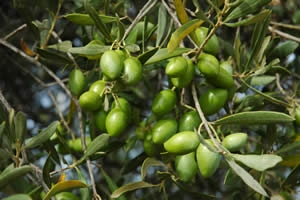About 16 years ago, well before I was a Master Gardener, I planted my first olive trees. My goal was simple. I wanted to block the view of a neighbor's collection of old non-working cars, trucks, boats and various other treasures.
My decision-making process was also simple. I was walking through Home Depot one day, saw nine Manzanilla olive trees in 15-gallon pots, thought olive trees were cool, so I bought them, took them home and planted them.
What have I learned from this experience? First, I'm a lucky person. All of my olive trees are alive and well despite being cared for by a former Midwestern with zero knowledge of olive trees. However, in the intervening years, I've learned a bit about them.
Did you know that some types require a pollinizer to produce olives? My Manzanilla trees did not produce much fruit until I planted two Picholine olive trees nearby.
Again, luck played a major role. I was strolling through the Napa Farmers' Market one day when McEvoy Ranch was selling olive trees. I bought two because I had room, and by chance they were Picholines, a pollinizer for Manzanilla.
Pruning slipped by me for the first 10 years or so. The trees grew tall and filled out, which I thought was the goal until I realized I had a jungle with fruit higher that I could reach with a ladder.
Folk wisdom says that olive trees should be thinned enough so that a bird can fly through them. A bird could do this in my little olive orchard only if it were carrying a chain saw.
For the last six years or so, I've been on a pruning rampage. I have reduced tree height to about eight feet, and it is now possible to walk between the trees.
Fortunately, olive trees are forgiving and can handle heavy pruning. Some fruit trees have a narrow window for pruning but not olive trees. I now do a heavy pruning in the winter and prune to shape and to remove suckers and water sprouts all year long. Someday I hope to witness a bird fly through my trees rather than over or around them.
It seems that all trees have an enemy or two, and olive trees are no different. I discovered early on that yellowed leaves with dark spotting and a halo around each spot were suffering from a fungal disease called peacock spot. This fungal disease causes partial defoliation, which weakens the tree and reduces fruit set. The fungus thrives when we get significant fall, winter and spring rain such as we had this past year.
The only preventive measure is to spray your trees with copper fungicide as early as possible after harvest. If you, like me, were lulled into a false sense of security by four years of drought and did not spray last year, there is nothing you can do now about peacock spot other than to hope it doesn't get worse. Note to self: spray this fall.
The major enemy of olive trees in our area is the olive fruit fly. An adult is only about a quarter-inch long, but these critters run in a gang and can ruin an entire crop. Three years ago, none of my olives was acceptable for curing or pressing. They all ended up in the garbage as they were not fit for compost either.
If you have any olive trees, you must take measures to combat the fruit fly even if you don't intend to harvest your olives. Doing nothing is akin to allowing an olive fruit fly hotel and spa to flourish before going on to your neighbors' trees where they will wreak havoc. If you want more information about control, you can find a wealth of information online.
I now have 22 olive trees. I have to say I enjoy them even when they present a problem or two. I find pruning to be therapeutic and the time spent harvesting in the fall most rewarding when I see those buckets of olives awaiting milling or curing.
Workshop: U. C. Master Gardeners of Napa County will hold a workshop on “Growing Olives” on Saturday, July 9, from 9:30 a.m. to 11:30 a.m., at Big Dog Ranch, 1020 Congress Valley Road, Napa. Learn what varieties to plant, where to plant them and how to maximize fruit size and yield. Presenters will also discuss drought tolerance, irrigation, harvesting methods and managing olive pests. On-line registration (credit card only) Mail-in/Walk-in registration (cash or check only).
Guided Tree Walk: Join U. C. Master Gardeners of Napa County for a free guided tree walk through Napa's Fuller Park on Monday, July 11, from 10 a.m. to 11:30 a.m. There is no charge for the walk but registration is recommended as space is limited. Meet at the corner of Jefferson and Oak Streets. Online registration or call 707-253-4221. Trees to Know in Napa Valleywill be available to purchase for $15 each. Cash or check payable to UC Regents. Sorry, we are unable to process credit cards.
Master Gardeners are volunteers who help the University of California reach the gardening public with home gardening information. U. C. Master Gardeners of Napa County ( http://ucanr.edu/ucmgnapa/) are available to answer gardening questions in person or by phone, Monday, Wednesday and Friday, 9 a.m. to Noon, at the U. C. Cooperative Extension office, 1710 Soscol Avenue, Suite 4, Napa, 707-253-4143, or from outside City of Napa toll-free at 877-279-3065. Or e-mail your garden questions by following the guidelines on our web site. Click on Napa, then on Have Garden Questions? Find us on Facebook under UC Master Gardeners of Napa County.
